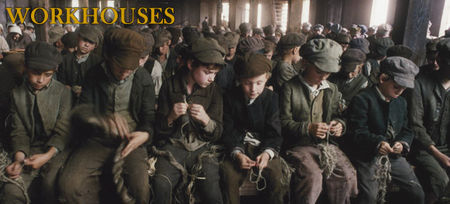workhouses
Un workhouse (foyer de travail), est un lieu qui accueille les personnes incapables de subvenir seules à leur besoin, en échange de leur travail.
Ces foyers furent officiellement crées en 1834, par le Poor Law Amendment Act ("Lois sur les Pauvres") se réfèrent à l'allocation d'une aide financière pour les plus pauvres , mais existaient déjà depuis la old poor law de 1601.
Why Did People Enter the Workhouse?
People ended-up in the workhouse for a variety of reasons. Usually, it was because they were too poor, old or ill to support themselves. This may have resulted from such things as a lack of work during periods of high unemployment, or someone having no family willing or able to provide care for them when they became elderly or sick. Unmarried pregnant women were often disowned by their families and the workhouse was the only place they could go during and after the birth of their child. Prior to the establishment of public mental asylums in the mid-nineteenth century (and in some cases even after that), the mentally ill and mentally handicapped poor were often consigned to the workhouse. Workhouses, though, were never prisons, and entry into them was generally a voluntary although often painful decision. It also carried with it a change in legal status — until 1918, receipt of poor relief meant a loss of the right to vote.
The operation of workhouses, and life and conditions inside them, varied over the centuries in the light of current legislation and economic and social conditions.
Work
Workhouse inmates — at least those who were capable of it — were given a variety of work to perform, much of which was involved in running the workhouse. The women mostly did domestic jobs such as cleaning, or helping in the kitchen or laundry. Some workhouses had workshops for sewing, spinning and weaving or other local trades. Others had their own vegetable gardens where the inmates worked to provide food for the workhouse.
Christmas in the Workhouse
In the era of some workhouse, prior to 1834, Christmas Day was the traditional occasion of a treat for most workhouse inmates. In others workhouses in the 1790s, the Christmas Day (and Whit Sunday) dinner included baked veal and plum pudding or veal and bacon for dinner, roast beef at Christmas, and 1lb. of spiced cake each at each of these festivals. And in others workhouses, at Christmas Day they inmate were allowed roast mutton, plum pudding, best cheese, and ale.
However, in the new union workhouses set up by the 1834 Poor Law Amendment Act, things were rather different, at least to begin with. The Poor Law Commissioners ordered that no extra food was to be allowed on Christmas day (or any other feast day). The rules also stated that "no pauper shall be allowed to have or use any wine, beer, or spirituous or fermented liquors, unless by the direction in writing of the medical officer." Despite the lack of festive fare, Christmas Day was (along with Good Friday and each Sunday) one of the special days when no work, except the necessary household work and cooking, was performed by the workhouse inmates.





 BIOGRAPHIE
BIOGRAPHIE



 There are heroes... there are superheroes...and there are hancock a drunkard with superhuman powers, including supersonic flight, invulnerability, immortality, and super-strength. Although he uses his powers to rescue people and stop criminals, his activities inadvertently cause millions of dollars in property damage to his constant intoxication and cynical attitude. As a result, he is routinely jeered by the public and is considered a nuisance by the Los Angeles police department. Hancock frequently ignores court subpoenas and lawsuits from the city of Los Angeles to address the property damage he has caused.
There are heroes... there are superheroes...and there are hancock a drunkard with superhuman powers, including supersonic flight, invulnerability, immortality, and super-strength. Although he uses his powers to rescue people and stop criminals, his activities inadvertently cause millions of dollars in property damage to his constant intoxication and cynical attitude. As a result, he is routinely jeered by the public and is considered a nuisance by the Los Angeles police department. Hancock frequently ignores court subpoenas and lawsuits from the city of Los Angeles to address the property damage he has caused. 